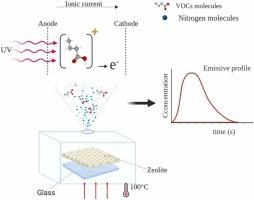Zeolite 5 A mediated palmitic acid detection in tomato seed oil by photoionization detector
IF 8
1区 化学
Q1 CHEMISTRY, ANALYTICAL
引用次数: 0
Abstract
Tomato seed oil (TSO) is an edible product characterized by a wide range of molecules, with beneficial effects on human health. Volatile organic compounds (VOC) formed from the degradation of fatty acids, are promising candidates for the characterization of vegetable oils. Hereafter, a sensor based on photoionization detector for palmitic acid is presented. The sensor exploits thermal emission profile analysis from a thin layer of zeolite 5 A. Emissive profiles were acquired through a Photoionization Detector (PID) at 100 °C. Specifically, the combination of use of zeolite with pore size of 5.1 Å and an ultraviolet lamp of 10.9 eV allows selective adsorption and detection of palmitic acid in a solution of pentane and TSO. The PID-zeolite sensor was investigated using oils at different dilution and at different storage conditions (−20 °C, 4 °C and 25 °C). Results evidenced that pentane dilution plays a significant role in palmitic acid adsorption, with a maximum emissive profile at ∼885 µmol/L. Low temperature storage (−20 °C) of samples before analysis results in 1.5 times higher emission peak due to the formation of triple chain molecular arrangement of palmitic acid. Calibration evidenced a linear range from 0.45 mmol/L up to 1.8 mmol/L with a sensitivity of 34.65 ppm∙mmol−1∙L and an R2 = 0.92. Real scenario analysis was performed a mixture of TSO with soybean oil (SO) at different storage stability. A significant emissive reduction in palmitic acid was observed in mixed oil, depending on its stability which allows for the evaluation of adulterated samples.

求助全文
约1分钟内获得全文
求助全文
来源期刊

Sensors and Actuators B: Chemical
工程技术-电化学
CiteScore
14.60
自引率
11.90%
发文量
1776
审稿时长
3.2 months
期刊介绍:
Sensors & Actuators, B: Chemical is an international journal focused on the research and development of chemical transducers. It covers chemical sensors and biosensors, chemical actuators, and analytical microsystems. The journal is interdisciplinary, aiming to publish original works showcasing substantial advancements beyond the current state of the art in these fields, with practical applicability to solving meaningful analytical problems. Review articles are accepted by invitation from an Editor of the journal.
 求助内容:
求助内容: 应助结果提醒方式:
应助结果提醒方式:


